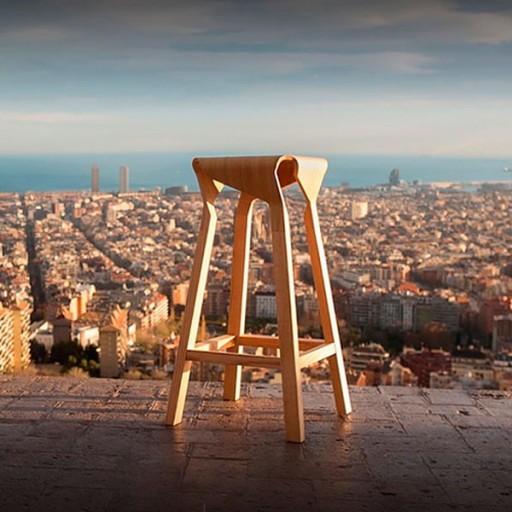Barack Obama, Christopher Pissarides (winner of the Nobel Prize for Economics, 2010), Finn Kydland (winner of the Nobel Prize for Economics, 2004), Bary Barish (winner of the Nobel Prize for Physics, 2017), and Dasho Karma Ura (Minister for Happiness of Bhutan) are some of its most notable champions. The circular economy is starting to establish itself at every level of society and industry as the only viable option for the consumer society that we have been shaping over the centuries.
Our “throwaway” attitude, which has, until now, been unshakeable, has begun to give way to a more logical and attractive way of doing things, one which respects nature and helps to complete the circle of life. The things we make must come with the guarantee that, once they are no longer useful, they can go back to where they came from or, at least not continue to fill our limited planet with flame-retardant and unrelenting waste.
The circular economy: more wood!
With the idea in mind of optimising natural resources and reducing the amount of waste that we produce, the circular economy has become essential in production processes around the world. As part of these processes, wood has become one of the key factors in this equation. In a low-carbon, circular economy in which the use of renewable, reusable, biodegradable, and recyclable materials predominates and is encouraged, wood has become one of the economy’s greatest allies, thanks to its versatility and its irreplaceable role in nature.
The logic is such that it is easy to dispel possible fears surrounding the risk of deforestation that come with wood being one of the main focuses of the economy of the future. Strengthening and reinforcing the sustainable management of forest resources has positive effects in both the long- and short-term for the areas in which the forests are located: it generates positive economic synergies, helps to prevent the risk of fires, creates jobs and has other knock-on effects in the rural environment which contribute to fighting the process of depopulation that these areas have been experiencing for decades. And for areas which are further away, it helps to guarantee the conservation of forests long-term.
In this sense, the figures are convincing. Spain, according to a document from the Foro del Papel “is, in fact, already a forestry power: we are the country in Europe with the fourth largest forest area, just behind Russia, Sweden, and Finland. In our country, many trees which can be cut down are planted: the annual growth of wood is 46.4 million m3 including bark and annual felling for all uses is limited to 15.5 million m3 not including bark (which makes up 33% of annual growth). In fact, the area covered by forest in Spain is growing: increasing from 13.8 million hectares in 1990 to 18.2 million hectares at present, according to figures from the Ministry for Agriculture, Food, and the Environment”. Furthermore, the wood industry provides the best chance for the conservation of the planet’s forests.
 The origins of wood are what makes it important for this historic change that the global economy is experiencing, at both a micro and macro level. “Wood is the result of photosynthesis, through which trees use the sun’s energy to capture CO2 from the atmosphere and convert it into wood, feeding itself in this way in order to grow”. “The 487,510 hectares of existing wood plantations in our country store 31.8 million tonnes of CO2 equivalent. Therefore, they are CO2 drains which help to slow down climate change. The carbon stored in these plantations remains in the paper products and the storage time increases when they are recycled”.
The origins of wood are what makes it important for this historic change that the global economy is experiencing, at both a micro and macro level. “Wood is the result of photosynthesis, through which trees use the sun’s energy to capture CO2 from the atmosphere and convert it into wood, feeding itself in this way in order to grow”. “The 487,510 hectares of existing wood plantations in our country store 31.8 million tonnes of CO2 equivalent. Therefore, they are CO2 drains which help to slow down climate change. The carbon stored in these plantations remains in the paper products and the storage time increases when they are recycled”.
In fact, “wood is available now, and will be available in future, from forests that are sustainably managed”, as pointed out in December 2016 by Rob Van Hoesel, the president of the European Federation of Wooden Pallet and Packaging Manufacturers (FEFPB). He also added that “across the UE, wood stocks are still increasing and the majority of forests are being sustainably managed under the certification schemes of the FCS or PEFC. This simple fact is the difference between wood and other materials like metals or plastic”.
The circular economy: a controlled circle
The reality of the arrival of the circular economy requires a legal framework which protects it and within which it can develop in order to occupy its own space which provides stability and necessary protection. The European Union is aware of this, and this can be seen in the approval in April by the European Parliament of several regulations related to the circular economy which look to improve waste management for the benefit of the environment and our health.
Wood is becoming an essential player within the circular economy, particularly in the construction sector, in which it plays a fundamental role. A more sustainable construction industry and energy efficiency are two of the biggest effects of, and reasons for, this new economic system. Wood’s characteristics make it the best option for saving energy during the useful life of a building and for improving thermal insulation.
The myriad options that this material offers and the benefits it provides for all economic sectors increase if its advantages are exploited using the correct processes. “In biological decomposition, be it natural or during controlled fermentation processes, the material is decomposed in phases by microorganisms, such as bacteria and fungi, which extract energy and nutrients from carbohydrates, fats, and proteins found in the material. For example, going from tree to furnace robs us of what could be obtained through decomposition in phases, through successive uses of wood and wood products prior to their deterioration and eventual incineration”, explains the Ellen MacArthur Foundation.



